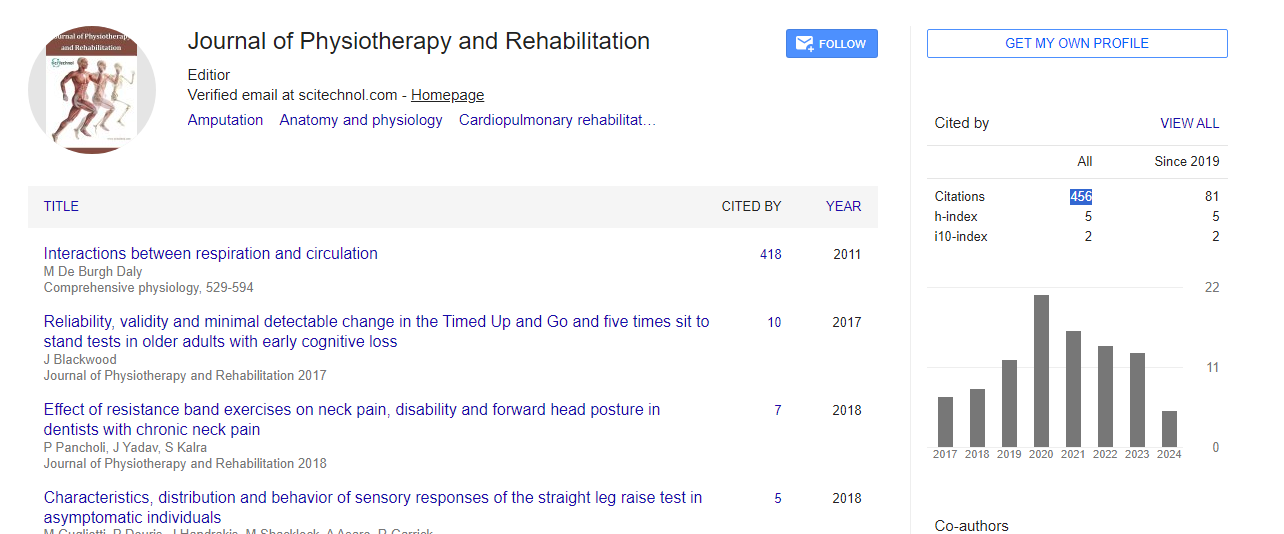Commentary, J Physiother Rehabi Vol: 8 Issue: 6
Effectiveness of Shoulder Physiotherapy in Treating Frozen Shoulder and Improving Daily Performance
Limin Morgan*
1Department of Physiotherapy, International Hellenic University, Thessaloniki, Greece
*Corresponding Author: Limin Morgan,
Department of Physiotherapy, International
Hellenic University, Thessaloniki, Greece
E-mail: morgan.lizen@edu
Received date: 23 November, 2024, Manuscript No. JPTR-24-155479;
Editor assigned date: 25 November, 2024, PreQC No. JPTR-24-155479 (PQ);
Reviewed date: 09 December, 2024, QC No. JPTR-24-155479;
Revised date: 17 December, 2024, Manuscript No. JPTR-24-155479 (R);
Published date: 24 December, 2024, DOI: 10.4172/JPTR.1000192.
Citation: Morgan L (2024) Effectiveness of Shoulder Physiotherapy in Treating Frozen Shoulder and Improving Daily Performance. J Physiother Rehabi 8:6.
Description
Frozen shoulder is a common condition characterized by pain, stiffness and restricted movement in the shoulder joint, the condition can significantly impair the ability to perform everyday activities, leading to decreased quality of life. While the condition can resolve over time, shoulder physiotherapy plays a essential role in accelerating recovery, managing pain and restoring functionality, allowing individuals to recover their independence. Shoulder physiotherapy is a non-invasive, conservative approach that aims to relieve pain, improve mobility and restore the shoulder's Range of Motion (ROM).
The freezing phase is marked by progressive pain and stiffness, making it increasingly difficult for individuals to move their shoulder. During this phase, the capsule of the shoulder joint becomes inflamed and scar tissue begins to form, leading to a decrease in the joint's mobility. Physiotherapy focuses on pain management, gentle stretching exercises and techniques to reduce inflammation. Techniques such as heat therapy, ultrasound and electrical stimulation are commonly used to relieve pain and improve circulation in the shoulder joint. Manual therapy techniques, including joint mobilizations can also be used to gently stretch the shoulder capsule and improve joint movement. At this point, shoulder physiotherapy continues to focus on maintaining mobility and preventing further stiffness. Stretching exercises are important in this phase, as they help maintain the range of motion.
Physical therapists may also use Passive Range of Motion (PROM) exercises, where they move the shoulder joint for the patient, to gently stretch the capsule and improve flexibility without causing discomfort or injury. Strengthening exercises may also be introduced, focusing on the surrounding muscles to provide stability and support to the shoulder joint. These exercises help counteract the weakening of muscles that often occurs when the joint is not moving freely. However, some individuals may still experience pain or reduced functionality. Physiotherapy during this phase focuses on improving strength, coordination, and overall shoulder function. Strengthening exercises are critical in this stage, as they help rebuild muscle strength and stamina that may have been lost during the freezing and frozen phases. Functional training exercises are also incorporated to ensure that individuals can perform everyday activities such as reaching, lifting and carrying objects without pain or limitations.
A comprehensive physiotherapy program for frozen shoulder is individualized based on the severity of the condition and the patient's specific needs. Therapists assess the patient's shoulder function and pain levels before creating a personalized treatment plan. In addition to manual therapy and exercise, education plays a significant role in shoulder rehabilitation. Shoulder physiotherapy not only helps in managing frozen shoulder but also plays an essential role in preventing recurrence. Once the shoulder’s range of motion and strength are restored, physiotherapy continues to focus on functional recovery and return to daily activities. In addition to the physical benefits, shoulder physiotherapy can provide emotional relief for individuals suffering from frozen shoulder. Chronic pain and reduced mobility can be irritation, leading to anxiety and depression. Physiotherapy not only addresses the physical symptoms of the condition but also provides emotional support, offering patients hope for recovery.
Conclusion
Shoulder physiotherapy plays an important role in the treatment of frozen shoulder by reducing pain, improving mobility and restoring functionality. Through a combination of manual therapy, stretching exercises, strengthening routines and education, physiotherapists can help patients recover from this weakening condition and recover their ability to perform daily tasks with ease. Early intervention and observance to a personalized rehabilitation program can significantly reduce recovery time and prevent long-term complications, allowing individuals to return to a more active, pain-free lifestyle.
 Spanish
Spanish  Chinese
Chinese  Russian
Russian  German
German  French
French  Japanese
Japanese  Portuguese
Portuguese  Hindi
Hindi 